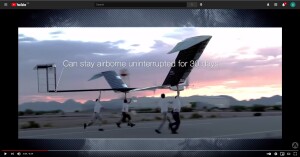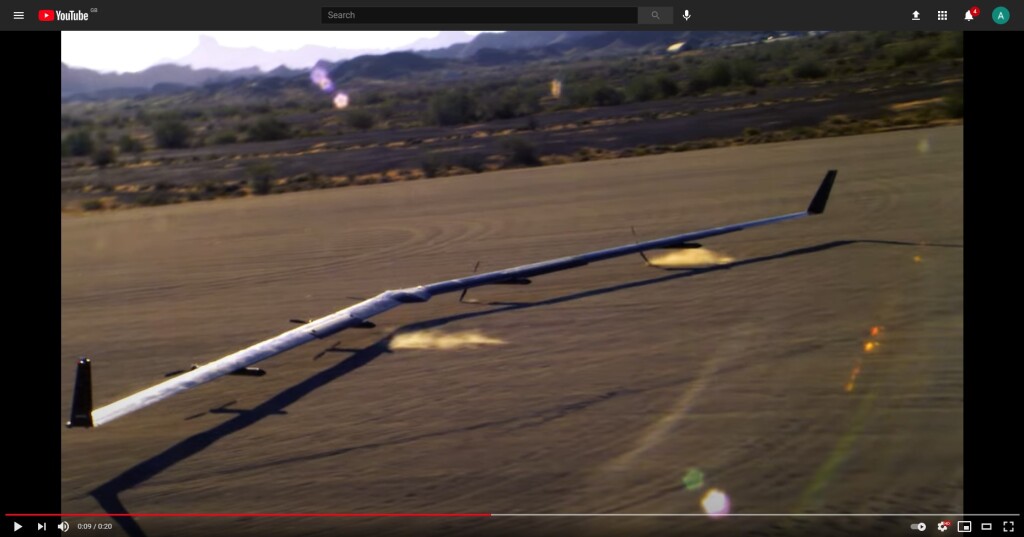Facebook Aquila 1A Drone Accident: Gust Induced Structural Failure
On 28 June 2016, while making its first flight, the Facebook UK Aquila 1A unmanned aircraft, N565AQ (serial number F1501), experienced an inflight structural failure on final approach near Yuma, AZ. The damage was induced by wind gusts say investigators.
The Facebook UK Aquila 1A UAS
In 2014 Facebook bought small British company Ascenta for £12mn. The company, now part of Facebook UK, was developing innovative solar drone technology. At the end of June 2016, the first aircraft produced in their warehouse in Bridgewater, Somerset, UK was dismantled and shipped to Arizona for flight test.
The four engined, solar-powered, trolley launched Aquila 1A Unmanned Air System (UAS), has over a 140 feet span but weights around 940lb.
The vehicle has four Joby Motor electric motors and four Facebook UK propellers. It is intended to have a 90 day endurance and relay internet signals to remote locations as part of Facebook’s intenet.org project.
Google-owned Titan Aerospace, which is also developing a solar-powered UAS for similar purposes, suffered the loss of its Solara 50 prototype N950TA on 1 May 2015, again to a structural failure, but in that case due to an overspeed.
The Safety Investigation
The National Transportation Safety Board (NTSB) say in their investigation report:
The flight launched in restricted airspace from [the US Army] Yuma Proving Ground‘s (YPG) Site 8 UAV runway. There were no anomalies noted during the 90-minute flight.
Facebook say they received “piloting and other support” from the University of Alaska Fairbanks‘, Alaska Centre for Unmanned Aircraft Systems Integration (ACUASI).
…at 0704, a simulated landing at 1,250 feet above sea level was performed to test the autoland feature of the autopilot. Autoland is the normal, and only, landing maneuver of the aircraft. The maneuver was executed normally, tracking the centerline and glidepath, and obeying the wave-off command. At the time of the simulated landing, the crew noted that the wind had increased above the intended test limit of 7 knots at flight altitude.
At 0737, the crew commanded a landing to the designated landing site. During the final approach, the aircraft encountered an increasing amount of turbulence and wind speeds of up to 10 knots at the surface and 12 to 18 knots, as measured by the aircraft at flight altitude. The operators post-flight telemetry analysis showed that the aircraft experienced significant deviations in pitch, roll, and airspeed, consistent with turbulence during the final approach.
At 0743, while on final approach at 20 feet above the ground, the right outboard wing experienced a structural failure with a downward deflection. Four seconds later, the aircraft impacted the ground at a groundspeed of 25 knots in an approximately wings-level attitude. The aircraft sustained substantial damage as a result of the impact and wing failure. As a result of the aircrafts design (skid landing gear, low-slung engines and propellers), the operator expected some damage during normal landings.
The operators analysis of available data indicates that the structural failure was likely initiated by a wind gust that lofted the aircraft above the glidepath about 5 seconds prior to failure. The autopilot responded to this gust by lowering the nose of the aircraft to reestablish itself on the glidepath. The airspeed then increased to 28 KIAS from the normal 24 KIAS. As the aircraft descended back onto the glidepath, the autopilot started to deflect the elevons upwards.
The operator determined that the combination of high airspeed, up elevon, and low angle of attack, resulted in increased downward lift (and torsion) on the outer wing panels. This loading exceeded its structural limit and resulted in a downward deformation and failure of the right wing. At the time of the last gust (5 seconds prior to touchdown) the aircraft was near idle power and the inboard propellers were commanded to the windmilling state – the highest drag configuration available to the autopilot.
The National Transportation Safety Board determined the probable cause to be:
A structural failure of the wing as a result of exceeding the airspeed envelope due to wind gusts which were beyond the capabilities of the autopilot.
Contributing to the accident was an insufficient amount of drag to track the glideslope in the presence of atmospheric disturbances.
Facebook Recommendations
In their accident report form, Facebook recommend:
- Adding a “modulatable drag device” (i.e. spoiler or airbrake) “to allow the autopilot to track both glideslope and airspeed”
- Modifying the autopilot logic to emphasise airspeed over glideslope.
UPDATE 19 December 2016: Facebook say:
We are already designing and building second-generation aircraft with new features added as a result of our learnings, and are eager to fly again. Each successive test flight will bring both expected and unexpected technical challenges, and will teach us more about how to fly this experimental aircraft. We intend to push the plane to its limits so we can learn more, learn faster, and reach our ultimate goal of connecting people sooner.
Providing connectivity with solar-powered aircraft is something that hasn’t been done before, and there are still a lot of hard science and engineering problems to solve. This is a hard, years-long challenge, and things will break along the way — that’s the nature of engineering. Our results from the first test flight have solidified our confidence in the Aquila program and what we can potentially achieve with this technology. As long as we continue to learn, the sky is the limit.
Other Resources
Top 8 Solar Powered Drone (UAV) Developing Companies
UPDATE 16 January 2017: The MIT Technology Review says: Using Drones to Bathe the World in Internet Isn’t Working Out So Great: Alphabet has scrapped its project. Facebook’s is struggling, too.
UPDATE 29 June 2017: Aquila’s second flight occurred on 22 May 2017…
…with take-off occurring just after dawn, and a total flight time of one hour and 46 minutes in the air. The drone rose to a flight ceiling of above 3,000 feet, and climbed at a rate that was double that of the first test flight — Aquila ascended at 180 feet/minute…
Aquila also tested new spoilers it has incorporated into the design to help it increase drag and reduce speed, and it tested radio signal strength aboard the craft. Those added spoilers also help with landing, the process of which was revised based on the first flight’s issues.
Facebook says that this new process, which included locking the propellers horizontally to reduce damage, worked mostly as designed — though only one propeller on the craft actually locked horizontally, while the rest remained vertical until landing…
UPDATE 27 June 2018: Facebook abandons its Project Aquila flying internet plan, or more specifically developing its own air vehicle:
….the company said it would instead partner with firms such as Airbus to continue its efforts to connect more people to the internet.
The decision means the closure of a facility in Bridgwater, UK…
“It’s been exciting to see leading companies in the aerospace industry start investing in this technology too – including the design and construction of new high-altitude aircraft,” wrote Yael Maguire, Facebook’s Director of Engineering, in a blog post.
See also: Facebook Cancels Program to Deliver Internet by Aquila Drones. This describes how:
For the 2017 test in Arizona, Facebook’s second Aquila prototype took off from a runway but landed successfully on a 150-meter circle of carefully groomed sand about 15 centimeters (6 inches) deep, christened the ‘Aquila Beach.’ Kevlar pads bonded to the plane’s motors reduced damage, although the plane’s propellers can be seen hitting the ground before the aircraft itself.
The company had been trying to establish a 600m diameter circular grass landing site at Spaceport America in New Mexico.
UPDATE 19 January 2019: Software Bug and High Winds Down Drone
UPDATE 28 August 2019: Drone Operation Injury: NTSB examine an injury caused after the loss of control of a UAS during a university demonstration.
UPDATE 12 January 2021: Inspection UAS Collides with PNG LNG Export Jetty
UPDATE 12 April 2021: USAF MQ-9A Reaper Lever Confusion: Human Factors
UPDATE 2 June 2021: Drone Pilot Injured in US Prison Geo-fence Incident
UPDATE 4 August 2022: Schiebel Camcopter S-100 Engine Failure Results in Baltic Crash







Recent Comments